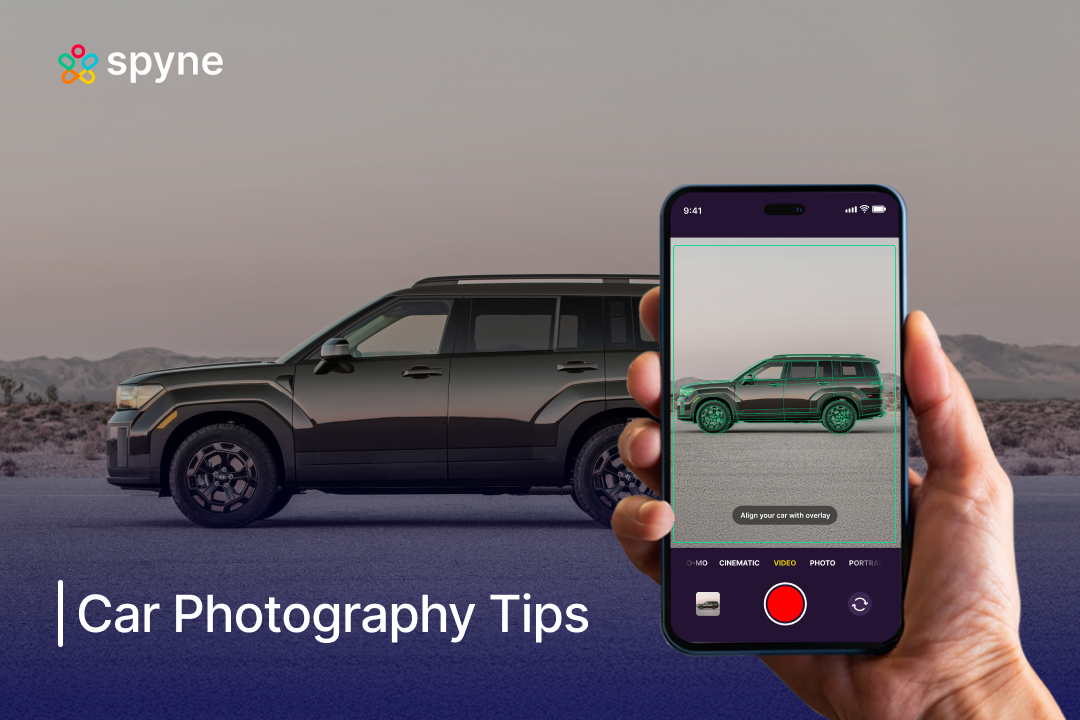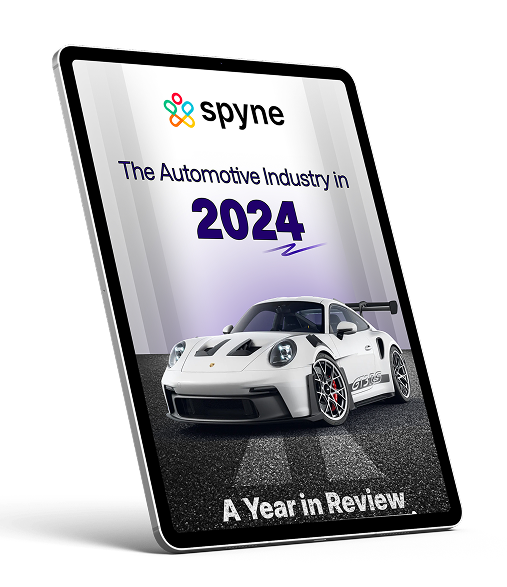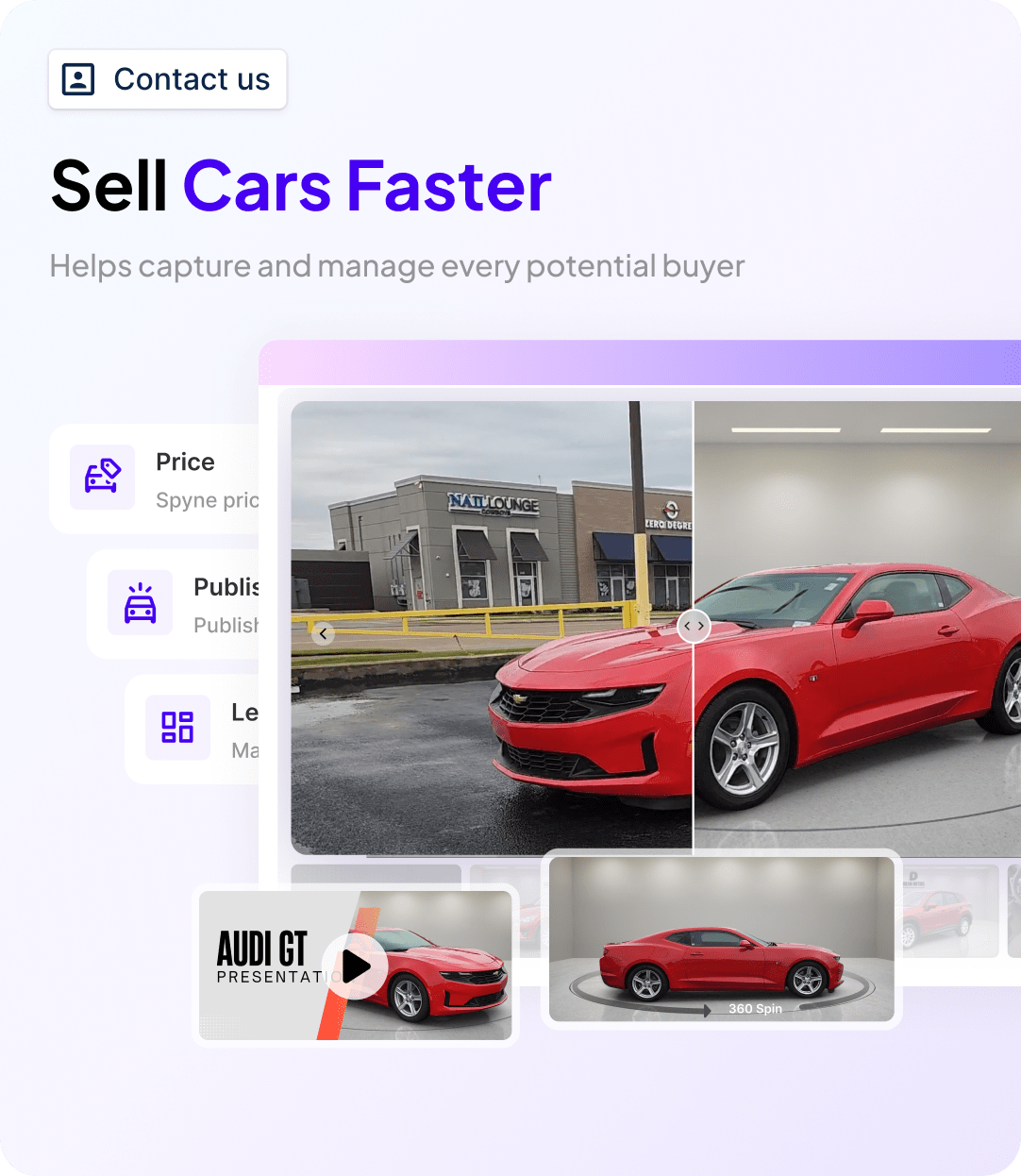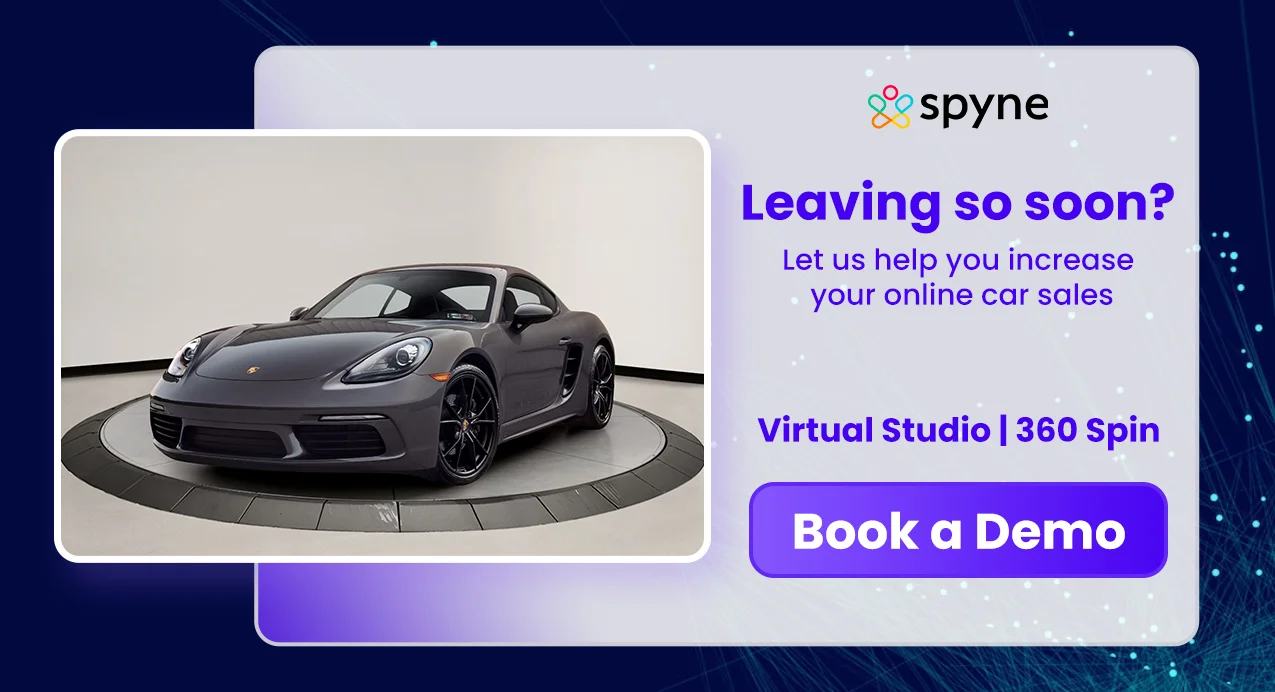Car buying was once an entirely offline process with buyers visiting dealerships, negotiating on-site, and completing paperwork in person. Fast forward to today, the automotive e-commerce market is undergoing a dramatic shift.
According to McKinsey’s Future of Auto Retail survey, one in three buyers are now open to purchasing their next car completely online, a significant shift from just a few years ago. Automotive e-commerce is rapidly catching up with showroom sales. This shift means a dealer’s digital presence will increasingly decide whether buyers engage or drop off.
User experience with your online car inventory starts with visuals. Car photography is the first impression shoppers get of your inventory, making it one of the most powerful tools to win trust and drive clicks.
This guide covers beginner-friendly car photography tips designed to help dealerships capture professional, attention-grabbing images that improve engagement and drive more conversions.
Understanding Car Photography Basics
Car photography is a specialized branch of photography dedicated to capturing vehicles in their best light, literally and figuratively. Every image has a story to tell, showing the curves, details, and essence of the car while evoking emotion in the viewer. It demands both technical precision and creative vision, combining light, angles, and composition to turn an automobile into a striking visual statement.
Car photography basically serves two primary purposes:
For Sales: Accuracy is key. The focus is on clear, detailed shots that highlight the car’s condition, features, and interiors, helping potential buyers make informed decisions online.
For Lifestyle/Branding: Creativity takes center stage, with vehicles showcased in aspirational environments or captured through dynamic action shots. The goal is to spark emotion, strengthen brand identity, and create a deeper connection with the audience.
No matter the context, the foundation of great results lies in following essential car photography tips:
- Lighting: Proper use of natural or artificial light to reveal details without harsh shadows.
- Angles: Choosing perspectives that enhance design and avoid distortion.
- Composition: Clean, balanced framing that keeps the car as the hero of the image.
- Reflections: Managing glossy surfaces like paint and glass to maintain clarity and professionalism.
Essential Gear & Setup for Car Photography
High-quality car photography requires more than just a good eye, it has to start with the right gear. The right tools don’t have to break the bank, but they do make the difference between average photos and showroom-quality images. Below is a list of essential gears required and car photography tips related to them.
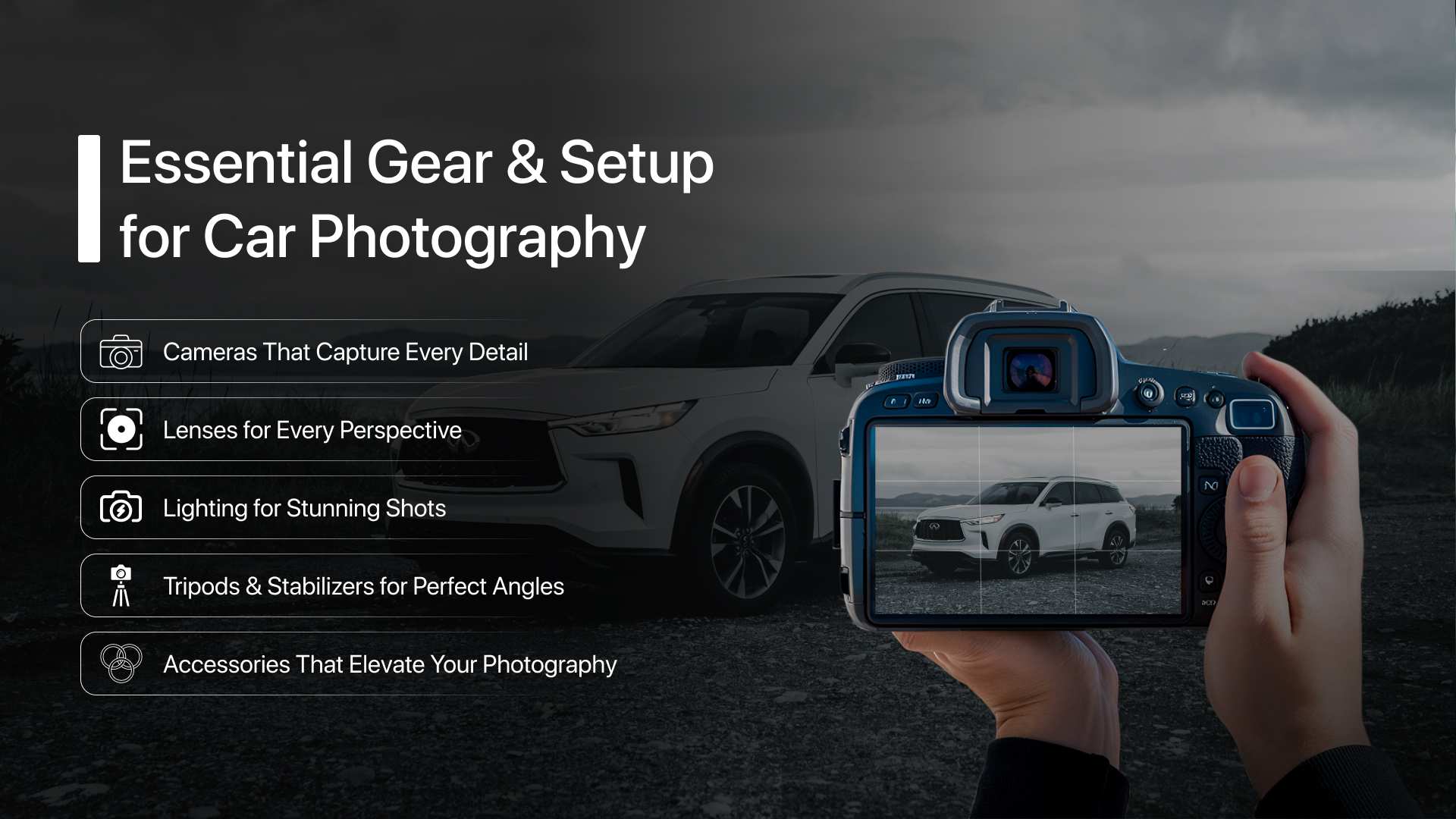
1. Type of Cameras
Choosing the right camera is the foundation of strong car photography. Each type be it DSLR, mirrorless, smartphone brings unique advantages and trade-offs. Picking one based on your budget and dealership workflow can make a big difference in consistency and overall image quality. Below are refined options with real models and specs to guide your car photography tips.
DSLR Cameras
- Delivers rich detail with high resolution sensors, very useful for large crop-ins of badge logos, trim details.
- Handles low light better, which is important for indoor showroom shots or golden hour exteriors.
- Example: Canon EOS 90D – 32.5 MP APS-C sensor, DIGIC 8 processor, excellent for “budget pro” level car images.
- Example: Nikon D7500 – good dynamic range, reliable in various lighting; strong battery life.
Smartphones
- Great for quick inventory shots, social media posts, or when budget or time limits DSLR/mirrorless use.
- Modern phone cameras (e.g. flagship phones) deliver very usable results, provided you avoid overexposure, use HDR smartly, and manage reflections.
- Example: iPhone 16/17 and flagship phones like Samsung Galaxy S24 Ultra.
2. Lenses for Different Shots
The lens you choose can completely change how a car looks in photos. Using the wrong lens often leads to distortion, making vehicles appear stretched, cramped, or unnatural. To get great results, car dealerships must know which lenses work best for exteriors, interiors, and close-ups.
- 24–70mm Zoom Lens: The most versatile choice for car photoshoot. It covers everything from wide exterior shots to tighter angles, ideal for capturing multiple cars in one shoot without having to switch lenses.
- 50mm Prime Lens: Known for its sharpness and natural perspective, this lens is perfect for detailed shots of logos, trims, and dashboard elements where clarity matters most.
- 16–35mm Wide-Angle Lens: Especially useful for cramped spaces like interiors. Capturing the full cabin in a single shot, ensuring buyers get a spacious, inviting view of the car’s inside.
- Macro Lens (Optional): Great for highlighting fine details such as stitching on seats, gear knobs, or unique design elements that add value in premium listings.
3. Tripods & Stabilizers
Even the most advanced camera can produce poor results if the shot is unstable. Tripods and stabilizers ensure every vehicle is photographed consistently, an important factor when buyers are scrolling through multiple listings from the same dealership. For video, these tools transform simple walkarounds into polished, cinematic experiences.
Tripod
- Provides rock-solid stability, eliminating shaky and blurred images.
- Allows consistent framing across all vehicle shots, creating a uniform look for dealership branding.
- Adjustable height ensures flexibility for shooting from low angles or eye level, depending on the car model.
Gimbal Stabilizer
- Essential for dealerships that are investing in video marketing and 360° walkarounds.
- Creates smooth, cinematic movement, making cars look more premium and professional in virtual tours.
- For instance the DJI OM 6, a popular choices for stable dealership videos.
4. Lighting Equipment
Lighting is the single biggest factor that determines whether a car looks appealing in photos. Poor lighting leads to glare, shadows, or dull tones, issues that can cause buyers to lose trust. By learning when to use natural vs. artificial light, car dealerships can achieve professional-looking results regardless of the environment.
Natural Light
- Works best during the golden hour (early morning or late afternoon), when sunlight is soft and flattering.
- Avoid midday sun, as it creates harsh shadows and highlights that can distort a car’s surfaces.
Artificial Lighting
- Portable LED panels provide reliable illumination for indoor showrooms or cloudy days.
- Softbox lights spread light evenly, reducing hotspots on glossy paint finishes.
- Ring lights are useful for detail shots, ensuring logos, interiors, or badges are well-lit.
Reflectors
- Reduce glare on windshields and chrome surfaces.
- Help balance shadows, making vehicles appear evenly lit and polished in photos.
5. Accessories That Make a Difference
Small accessories often separate average photos from professional dealership imagery. They are affordable, easy to use, and ensure your car listings remain consistent and high-quality across every listing.
- Polarizing Filter: Cuts reflections on glass and glossy paint.
- Microfiber Cloths: Keeps cars spotless before shooting.
- Remote Shutter Release: Prevents camera shake.
- Background Screens: Standardise look across dealership listings.
Best Car Photography Tips
Car photography is both an art and a science. While creativity drives emotional appeal, dealerships and sellers also need accuracy and consistency to convert interest into sales. Below are 20 expert-backed tips, grouped into angles, lighting, composition, and editing, to help you capture vehicles in their best light.
1. Choose the Right Time of Day
Lighting is the foundation of every great photo, and cars respond best to soft, even light. Shooting at the wrong time leads to harsh reflections and poor shadows.
- Golden hour (sunrise or sunset) gives warm tones and natural highlights that flatter body lines.
- Midday light often creates glares; use diffusers, shade, or shoot on overcast days for softer tones.
- For dramatic effect, twilight or night shots with artificial lighting can make cars stand out against cityscapes.
2. Scout the Perfect Location
The right setting can either elevate your car photos or completely ruin them. A strong location frames the vehicle naturally and aligns with its personality, making the images more impactful.
- For luxury sedans: sleek cityscapes, glass buildings, and modern architecture reinforce sophistication.
- For SUVs and trucks: rugged trails, mountain passes, or wide-open roads highlight durability and power.
- Always visit the location at the same time of day you’ll be shooting to check for natural light, traffic flow, and possible distractions.
- Use of a well-scouted backdrop like a white background esures your car is the hero, not the clutter behind.
3. Clean and Detail the Car Before Shooting
No matter how skilled you are behind the camera, a dirty car will always make photos look unprofessional. Proper detailing ensures the vehicle looks showroom-ready in every shot.
- Wash, wax, and polish the exterior to make the paint pop and wheels shine.
- Clean all glass surfaces, windshields, windows, and mirrors — to avoid smudges.
- Wipe infotainment screens, dashboards, and seats with microfiber cloths for spotless interiors.
- Keep quick-detailing sprays and microfiber towels handy during the shoot for last-minute touch-ups.
4. Master the Three-Quarter Angle
Among the most widely recommended car photography tips, the three-quarter angle is a classic because it gives a complete view of the vehicle’s stance and design.
- Position the camera around 45° from the front to capture both the front fascia and side profile.
- Keep your lens slightly above wheel level for depth and proportional balance.
- Works for every car category like compact hatchbacks, luxury sedans, and even supercars.
- Ideal for dealerships, ads, and online listings where a single photo must tell the whole story.
5. Experiment With Low Angles
If you want your car photos to exude power and authority, shoot from below eye level. Low angles make vehicles appear stronger and more imposing.
- Place the camera near the ground to emphasize size and stance.
- For sports cars: highlight aerodynamic lines and speed-driven design.
- For SUVs and trucks: draw attention to ground clearance and ruggedness.
- A tripod or mini-pod can help you keep stability at such angles.
6. Highlight the Details That Matter
Beyond the body lines, the soul of a car lies in its details. Detail shots add character, highlight craftsmanship, and make your gallery feel complete.
- Focus on design elements like grilles, headlights, alloy wheels, exhausts, and emblems.
- Don’t neglect interiors like stitching, gear shifters, or steering wheel controls tell their own story.
- A 50mm prime lens captures details with sharp clarity and minimal distortion.
- These shots break monotony and appeal to both car buyers and enthusiasts.
7. Choose the Right Lens for the Job
Your lens determines how the car’s proportions, depth, and sharpness translate into the final image. Choosing wisely ensures your photos tell the right story.
- 24–70mm zoom lens: the most versatile choice for exteriors and standard angles.
- 16–35mm wide-angle lens: excellent for interiors, but used carefully to avoid warping.
- 50mm or 85mm primes: deliver cinematic, tack-sharp detail shots.
- Investing in high-quality lenses is one of the most valuable car photography tips for long-term results.
8. Control Reflections and Glare
Cars are reflective surfaces, and nothing ruins a photo faster than unwanted reflections. Knowing how to manage glare ensures clean, professional results.
- Use a polarizing filter to reduce reflections on windshields and glossy paint.
- Adjust your shooting position to minimize capturing yourself or clutter in the reflections.
- Choose neutral, distraction-free environments that won’t mirror unwanted objects on the car’s surface.
- Overcast skies are great for reducing glare naturally.
9. Balance Natural and Artificial Lighting
The right blend of light sources can take your car shots from average to extraordinary. While natural light is beautiful, artificial lighting gives you more control.
- Use reflectors to bounce sunlight into shaded parts of the car.
- Soft LED panels or portable light bars can brighten interiors or evening exteriors.
- Always match color temperatures, mixed lighting (yellow and white) can ruin the natural look.
- Balanced lighting ensures the car looks polished without appearing staged.
10. Capture Interiors With Precision
Car interiors are where buyers imagine themselves, so they must look as inviting and premium as possible. A well-shot cabin conveys comfort and technology.
- Use wide-angle lenses to capture the dashboard and seating, but avoid stretching proportions unnaturally.
- Focus on infotainment screens, gear knobs, stitching, and textures to show craftsmanship.
- Turn on ambient lights, backlit displays, or navigation systems for an atmospheric look.
- Take multiple angles, driver’s view, backseat view, and close-ups — to provide a complete experience.
11. Add Motion to Your Shots
Static photos highlight design, but motion shots bring cars to life. Capturing movement conveys speed, excitement, and energy, making photos more dynamic.
- Use panning techniques: keep the camera moving with the car while using a slower shutter speed (1/30–1/60 sec).
- For rolling shots, shoot from a moving vehicle alongside your subject for cinematic blur.
- Motion is one of the most underrated car photography tips to showcase performance and thrill.
12. Explore Aerial and Drone Perspectives
Aerial photography gives viewers a perspective they rarely see, cars from above. This adds drama and scale, especially in outdoor or scenic settings.
- Use drones for top-down shots that highlight winding roads, scenic highways, or rugged mountain trails.
- Experiment with diagonals or curves in landscapes to create dynamic compositions that emphasize movement and flow.
- Check local drone regulations before flying to ensure compliance and avoid legal or safety issues during shoots.
13. Frame Cars Creatively With Their Surroundings
A car rarely exists in isolation, the environment can make your shots more engaging. Framing draws the eye toward the car and adds storytelling depth.
- Use natural frames like tunnels, tree canopies, or archways.
- Roads, fences, or bridges can act as leading lines guiding attention.
- Blending car and environment is one of the most creative car photography tips for lifestyle shoots.
14. Play With Symmetry and Balance
Cars are designed with balance in mind, their lines, curves, and proportions often mirror each other. Highlighting this symmetry creates photos that are visually striking and instantly professional.
- Shoot directly from the centerline, either front or rear, to emphasize clean design proportions.
- Use reflections in puddles, glass buildings, or polished floors to create striking mirrored effects.
- Frame cars with symmetrical environments like tunnels, bridges, or parking garages for stronger compositions.
15. Capture Cars in Their Natural Habitat
A studio photo looks polished, but lifestyle photography connects emotionally with buyers. Place the car in settings that align with its purpose and audience.
- SUVs look more authentic on dirt trails, hills, or rugged roads.
- Convertibles shine in coastal drives, while sedans pair well with city backdrops.
- Matching car and setting is a practical car photography tip that adds relatability.
16. Edit With Precision and Restraint
Editing should enhance the photo, not misrepresent the car. Over-processing leads to unrealistic results that reduce trust.
- Adjust contrast, saturation, and highlights subtly with tools like car colour changer tool to make image pop.
- Retouch small distractions but avoid heavy filters.
- Professional car photography tips always stress: “Less is more” in post-production.
17. Use HDR for Challenging Lighting
Cars often sit in environments with strong contrasts, shiny metal, glass, and deep shadows. HDR balances these extremes.
- Take multiple exposures and merge them for detail retention.
- Best for interiors where sunlight hits unevenly.
- Keep the HDR effect natural; avoid overly dramatic tones that look fake.
18. Apply Exposure Bracketing for Accuracy
Lighting can make or break a car photo, especially with reflective surfaces like chrome, metallic paint, and glass. Exposure bracketing is a simple but powerful car photography tip to ensure you never lose critical details.
- Capture 3–5 shots at varied exposures: underexposed, normal, and overexposed.
- Merge exposures during post-production to achieve balanced highlights, shadows, and mid-tones.
- Keep all shots aligned by using a tripod for sharper, more consistent results.
- Especially effective for metallic paints, chrome details, and cars photographed under direct sunlight.
19. Tell a Story Through Sequences
A single photo can impress, but a sequence tells a journey. Storytelling keeps viewers hooked longer and conveys the car’s personality.
- Begin with wide shots that establish the car in its environment, setting mood and context.
- Move to medium frames that highlight stance, body lines, and interiors for a closer connection.
- Finish with detailed close-ups of headlights, stitching, wheels, or badges to showcase craftsmanship.
- This structured storytelling approach is one of the most effective car photography tips for dealerships, ads, and car merchandising.
20. Keep Consistency for Dealerships and Online Listings
Consistency is critical when shooting cars for commercial use. Buyers browsing online trust listings that look professional and uniform.
- Use the same angles across all vehicles like front, rear, side, ¾ view, and interior shots.
- Stick to neutral backdrops that are clean and uncluttered to avoid distractions and highlight the car.
- Keep a consistent style in lighting, framing, and editing to create a polished, reliable dealership presence.
Conclusion
Online car sales are still largely led by big players in the industry but that’s changing fast. As automotive e-commerce grows more competitive, buyers are actively exploring multiple sources, even looking out of state for better options and pricing.
It means your dealership’s online presence can no longer be an afterthought. High-quality photos, well-optimized listings, and interactive engagement tools are going to be deal breakers. They make your buyers stop scrolling and start considering your inventory seriously.
What’s the one thing you could change about your car listings today that would make the biggest difference tomorrow?
With solutions like Spyne, dealerships can manage the entire journey from one place such as capturing professional-quality car photos, optimizing and distributing listings, and engaging buyers with interactive experiences that replicate the showroom feel.
If your dealership listing is attracting viewers but failing to convert, our team can help you identify gaps and optimize for higher lead retention.
Frequently Asked Questions
Simple car photography tips like cleaning the car, using the best angles for car photography, and shooting in good natural light can make used cars look fresh. Spyne’s AI image editor further enhances automotive photography by removing flaws and standardizing backgrounds, making listings look professional and trustworthy.
To reduce reflections, try car photography angles where light doesn’t bounce directly off the surface, or use polarizing filters. These automotive photography tips help you capture sharper details with less glare. Spyne’s AI image editor can also auto-correct reflections for clean, distraction-free images.
When applying car photography ideas, avoid cluttered backgrounds, personal items inside cars, or distracting props. Professional car photos highlight vehicles without unnecessary elements. Neutral backdrops and clean framing ensure focus stays on the car itself, showcasing the best angles for car photography and boosting dealership credibility.
Branded overlays unify listings, ensuring all images reflect dealership identity. This adds credibility and consistency, important in car photography tips. Templates paired with professional car photography angles and Spyne’s AI image editor make vehicles instantly recognizable, enhancing trust while improving the overall buyer experience.
Background uniformity ensures clean, distraction-free car photography ideas that highlight the vehicle. Listings with consistent backdrops rank better in searches and grab buyer attention quickly. Automotive photography tips like using plain backgrounds or AI-powered editors, such as Spyne, ensure the best angles for car photography stand out without clutter.
Dealerships can maintain consistency by using automated car photography tips like AI-based editing tools. Spyne’s AI image editor ensures uniform backgrounds, lighting, and best angles for car photography across large inventories. This streamlines operations, letting teams shoot quickly while still delivering professional automotive photography tips at scale.
Yes, the order of photos directly affects engagement. Starting with the best angles for car photography like front ¾ shots, interiors, and detail close-ups, captures attention fast. Applying smart car photography ideas ensures buyers stay longer on listings. Organized, consistent flow reflects professionalism and can boost clicks and inquiries.
Car photographers often face challenges like unwanted reflections, tricky lighting conditions, and the difficulty of capturing motion without distortion. Overcoming these requires smart techniques: using polarizers and diffusers to control glare, shooting during golden hours for natural lighting, and employing panning for dynamic motion shots. A sturdy tripod ensures stability, while carefully chosen locations add depth, storytelling, and a professional edge to every photograph.

